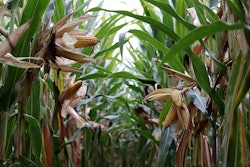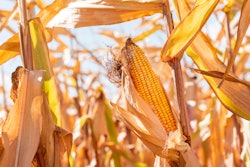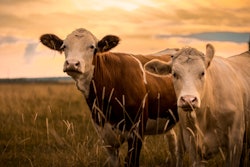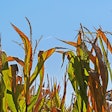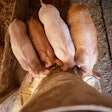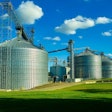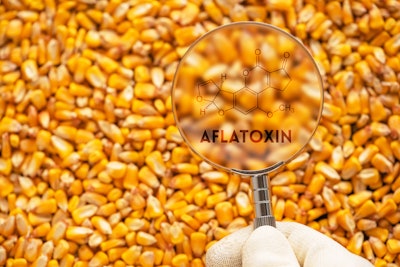
Weather conditions during this year’s North American corn-growing season may increase chances of mycotoxin contamination, experts said.
Aflatoxin is being reported in drought-affected corn, said Tim Evans, veterinary toxicologist with the University of Missouri Extension,in a report. He said livestock producers should test for aflatoxin,which can cause reduced feed intake, reduced weight gain, liver damage, jaundice and eventually death.
“One of the common problems we have with aflatoxin are violated levels in milk. Dairy cows, if exposed to a tiny amount of aflatoxin, can have it show up in the milk and then, that’s a violation.”
He said if aflatoxins are present in milk, it must be dumped.
“In dairy, because they’re producing milk, the concentration that’s allowed is very low – 20 parts per billion. However, that amount is likely not going to harm the dairy cow. It will probably take about several hundred parts per billion to harm the cow itself,” he said. However, he added, “looking at breeding cattle and finishing beef cattle, they might be able to have up to 300 parts per billion and the diet is still allowed.”
Evans advises livestock producers who purchase corn from drought-affected areas to send samples to a laboratory for mycotoxin testing.
Risks from too much rain
In other areas of the U.S. and Canada, high rainfall during the growing season also increases risk for mycotoxin contamination.
“In Southern Ontario, for example, we had much higher-than-normal rainfall levels in late summer, including some flooding, in major corn growing regions,” said Paul Garvey withCBS Bio Platformsin a press release. “The corn crop has been stressed and harvest will be later. The good news is we’re expecting strong yields. But anytime in the past we’ve stressed the crop and had a later harvest, it’s been more prone to mycotoxin concerns. Taking steps to protect feed is a good insurance policy to protect the investment in each animal.”
Higher feed prices mean it is even more important to test for mycotoxins, he said.
“Making the most out of every feed dollar is crucial to protect margins,” Garvey said. “Because mycotoxins are often a hidden cost, especially when the risk is high, it pays to be proactive and have a solution in place.”Weather conditions during this year’s North American corn-growing season may increase chances of mycotoxin contamination, experts said.
Aflatoxin is being reported in drought-affected corn, said Tim Evans, veterinary toxicologist with the University of Missouri Extension, in a report. He said livestock producers should test for aflatoxin, which can cause reduced feed intake, reduced weight gain, liver damage, jaundice and eventually death.
“One of the common problems we have with aflatoxin are violated levels in milk. Dairy cows, if exposed to a tiny amount of aflatoxin, can have it show up in the milk and then, that’s a violation.”
He said if aflatoxins are present in milk, it must be dumped.
“In dairy, because they’re producing milk, the concentration that’s allowed is very low – 20 parts per billion. However, that amount is likely not going to harm the dairy cow. It will probably take about several hundred parts per billion to harm the cow itself,” he said. However, he added, “looking at breeding cattle and finishing beef cattle, they might be able to have up to 300 parts per billion and the diet is still allowed.”
Evans advises livestock producers who purchase corn from drought-affected areas to send samples to a laboratory for mycotoxin testing.
Risks from too much rain
In other areas of the U.S. and Canada, high rainfall during the growing season also increases risk for mycotoxin contamination.
“In Southern Ontario, for example, we had much higher-than-normal rainfall levels in late summer, including some flooding, in major corn growing regions,” said Paul Garvey with CBS Bio Platforms in a press release. “The corn crop has been stressed and harvest will be later. The good news is we’re expecting strong yields. But anytime in the past we’ve stressed the crop and had a later harvest, it’s been more prone to mycotoxin concerns. Taking steps to protect feed is a good insurance policy to protect the investment in each animal.”
Higher feed prices mean it is even more important to test for mycotoxins, he said.
“Making the most out of every feed dollar is crucial to protect margins,” Garvey said. “Because mycotoxins are often a hidden cost, especially when the risk is high, it pays to be proactive and have a solution in place.”






